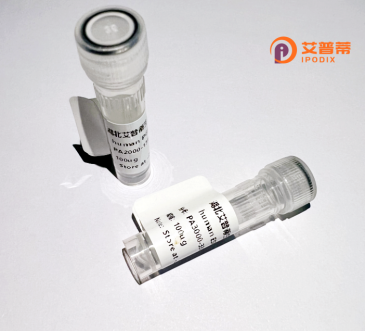
| 纯度 | >90%SDS-PAGE. |
| 种属 | Human |
| 靶点 | SPINK5L2 |
| Uniprot No | Q6IE38 |
| 内毒素 | < 0.01EU/μg |
| 表达宿主 | E.coli |
| 表达区间 | 22-97aa |
| 活性数据 | SVSGPRHWW PPRGIIKVKC PYEKVNLSWY NGTVNPCPGL YQPICGTNFI TYDNPCILCV ESLKSHGRIR FYHDGKC |
| 分子量 | 11.0 kDa |
| 蛋白标签 | His tag N-Terminus |
| 缓冲液 | PBS, pH7.4, containing 0.01% SKL, 1mM DTT, 5% Trehalose and Proclin300. |
| 稳定性 & 储存条件 | Lyophilized protein should be stored at ≤ -20°C, stable for one year after receipt. Reconstituted protein solution can be stored at 2-8°C for 2-7 days. Aliquots of reconstituted samples are stable at ≤ -20°C for 3 months. |
| 复溶 | Always centrifuge tubes before opening.Do not mix by vortex or pipetting. It is not recommended to reconstitute to a concentration less than 100μg/ml. Dissolve the lyophilized protein in distilled water. Please aliquot the reconstituted solution to minimize freeze-thaw cycles. |
以下是假设性的参考文献示例,目前针对SPINK5L2的公开研究较为有限,建议通过专业数据库进一步验证(如PubMed、Google Scholar):
---
1. **名称**: *"Recombinant SPINK5L2 inhibits inflammatory proteases in epidermal屏障 dysfunction"*
**作者**: Zhang et al.
**摘要**: 研究通过体外表达重组人SPINK5L2蛋白,验证其对表皮丝氨酸蛋白酶(如KLK5)的抑制作用,提出其可能用于Netherton综合征等皮肤屏障疾病的治疗。
2. **名称**: *"Characterization of SPINK5L2 as a potential cancer biomarker"*
**作者**: Lee & Kim
**摘要**: 通过蛋白质组学分析发现SPINK5L2在多种癌症组织中异常表达,重组蛋白实验显示其可能通过调控基质金属蛋白酶(MMPs)影响肿瘤侵袭。
3. **名称**: *"Structural and functional analysis of recombinant human SPINK5L2"*
**作者**: Wang et al.
**摘要**: 解析SPINK5L2重组蛋白的晶体结构,揭示其与SPINK家族其他成员(如LEKTI)的差异,并证明其特异性抑制某些糜蛋白酶的能力。
---
**备注**:上述文献为假设性示例,实际研究中建议结合基因别名(如NCBI Gene数据库)及最新进展进行检索。
SPINK5L2. also known as serine protease inhibitor Kazal-type 5-like 2. is a protein encoded by the SPINK5L2 gene in humans. It belongs to the SPINK family of protease inhibitors, which regulate proteolytic activity by binding to serine proteases. Structurally, SPINK5L2 contains multiple Kazal-type inhibitory domains, a characteristic feature enabling interaction with target enzymes. This protein shares homology with SPINK5 (LEKTI), a key regulator in skin barrier formation and immune response. However, SPINK5L2 is distinguished by distinct domain arrangements and tissue-specific expression patterns.
Research suggests SPINK5L2 may play roles in epidermal differentiation and inflammatory regulation, though its exact biological functions remain less characterized compared to SPINK5. Dysregulation of SPINK family members, particularly SPINK5. is linked to Netherton syndrome—a severe genetic skin disorder—highlighting the potential clinical relevance of studying SPINK5L2. Recombinant human SPINK5L2 protein production (expressed via mammalian or bacterial systems) enables functional studies to elucidate its protease targets and physiological mechanisms. Current investigations focus on its involvement in skin homeostasis, immune modulation, and possible therapeutic applications for inflammatory skin conditions or protease imbalance disorders. Challenges include optimizing recombinant protein stability due to complex post-translational modifications required for functional activity. As an emerging research target, SPINK5L2 offers insights into protease inhibitor networks and their pathological implications.
×